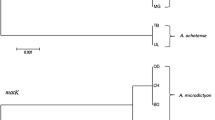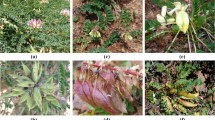Abstract
Identification of plant species is important for standardizing herbal medicine. Cynanchum wilfordii (Baekshuoh in Korean) and Polygonum multiflorum (Hashuoh in Korean) are important oriental medicinal herbs in Korea, Japan, and China. Cynanchum auriculatum is a faster growing and more productive plant than C. wilfordii; and, it is not recognized as a medicinal plant in the Korean Pharmacopoeia. C. wilfordii, P. multiflorum, and C. auriculatum are often misidentified in the Korean herbal medicine marketplace due to their morphological similarities and similar names. In this study, we investigated molecular authentication of these three medicinal plants using DNA sequences in the TrnL-F chloroplast intergenic region. Specific species identification was achieved by detecting allelic variations of single nucleotide polymorphisms (SNPs) using amplification refractory mutation system-polymerase chain reaction (ARMS-PCR) and high resolution melting curve analysis. Our results demonstrate that the intraspecific genetic distance between C. wilfordii and C. auriculatum is relatively low. We also developed a quantitative PCR assay using species-specific TrnL-F primers, which allowed us to estimate the ratio of C. wilfordii and C. auriculatum using varying ratios of mixed genomic DNA template from the two species. Additionally, to identify species in hybrid plants produced by cross-fertilization, we analyzed nuclear ribosomal DNA internal transcribed spacer regions in C. wilfordii and C. auriculatum by ARMS-PCR. Our results indicate that SNP-based molecular markers, usable to barcode tools could provide efficient and rapid authentication of these closely related medicinal plant species, and will be useful for preventing the distribution of products contaminated with adulterants.





Similar content being viewed by others
References
Kim MK, Wang H, Kim YJ, Sathiyamoorthy S, Kwon WS, Yang DC (2013) Molecular authentication by multiplex-PCR of three similar medicinal plant species: Cynanchum wilfordii, Cynanchum auriculatum and Polygonum multiflorum (Fallopia multiflorum). J Med Plant Res 35:2584–2589
Liang Z, Leung NN, Chen H, Zhao Z (2012) Quality evaluation of various commercial specifications of Polygoni multiflori radix and its dregs by determination of active compounds. Chem Cent J 6:53
Korea Food and Drug Administration (2008) The 9th Korean Herbal Pharmacopoeia, vol 255. Korea Food and Drug Administration, Seoul, pp 107–1088
Zhu S, Fushimi H, Cai S, Komatsu K (2004) Species identification from ginseng drugs by multiplex amplification refractory mutation system (MARMS). Planta Med 70:189–192
Song KS, Shin CG, Ju YS (2004) External and internal morphological standard of original plants and herbal states in Polygoni multiflori and Cynanchi wilfordii radix. Kor J Herbol 19:55–66
Kim MJ, Kim IJ, Choi SY, Han DH, Kim YH, Lim SC, Kim TJ, Nam SY, Song BH, Oh BU, Park CG (2014) Comparison of Cynanchum wilfordii, C. auriculatum, Metaplexis japonica and Polygonum multiflorum by morphological characters. Kor J Medicinal Crop Sci 22:113–120
Jung J, Kim KH, Yang K, Bang KH, Yang TJ (2014) Practical application of DNA markers for high-throughput authentication of Panax ginseng and Panax quinquefolius from commercial ginseng products. J Ginseng Res 38:123–129
Moon BC, Choo BK, Cheon MS, Yoon T, Ji Y, Kim BB, Lee AY, Kim HK (2010) Rapid molecular authentication of three medicinal plant species, Cynanchum wilfordii, Cynanchum auriculatum, and Polygonum multiflorum (Fallopia multiflorum), by the development of RAPD-derived SCAR markers and multiplex-PCR. Plant Biotechnol Rep 4:1–7
Reboud X, Zeyl C (1994) Organelle inheritance in plants. Heredity 72:132–140
Pyke KA (1999) Plastid division and development. Plant Cell 11:549–556
McCauley DE (1995) The use of chloroplast DNA polymorphism in studies of gene flow in plants. Trends Ecol Evol 10:198–202
Yang JY, Jang SY, Kim HK, Park SJ (2012) Development of a molecular marker to discriminate Korean Rubus species medicinal plants based on the nuclear ribosomal DNA internal transcribed spacer and chloroplast trnL-F intergenic region sequences. J Kor Soc Appl Biol Chem 55:281–289
Tamura K, Stecher G, Peterson D, Filipski A, Kumar S (2013) MEGA6: molecular evolutionary genetics analysis version 6.0. Mol Biol Evol 30:2725–2729
Newton CR, Graham A, Heptinstall LE (1989) Analysis of any point mutation in DNA. The amplification refractory mutation system (ARMS). Nucl Acids Res 17:2503–2516
Liu J, Huang S, Sun M, Liu S, Liu Y, Wang W, Zhang X, Wang H, Hua W (2012) An improved allele-specific PCR primer design method for SNP marker analysis and its application. Plant Method 8:34
Mackay JF, Wright CD, Bonfiglioli RG (2008) A new approach to varietal identification in plants by microsatellite high resolution melting analysis: application to the verification of grapevine and olive cultivars. Plant Method 4:8
Muleo R, Colao MC, Miano D, Cirilli M, Intrieri MC, Baldoni L, Rugini E (2009) Mutation scanning and genotyping by high-resolution DNA melting analysis in olive germplasm. Genome 52:252–260
Osathanunkul M, Suwannapoom C, Osathanunkul K, Madesis P, de Boer H (2016) Evaluation of DNA barcoding coupled high resolution melting for discrimination of closely related species in phytopharmaceuticals. Phytomedicine. doi:10.1016/j.phymed.2015.11.018
Buddhachat K, Osathanunkul M, Madesis P, Chomdej S, Ongchai S (2015) Authenticity analyses of Phyllanthus amarus using barcoding coupled with HRM analysis to control its quality for medicinal plant product. Gene 573:84–90
Park MJ, Kim MK, In JG, Yang DC (2006) Molecular identification of Korean ginseng by amplification refractory mutation system—PCR. Food Res Int 39:568–574
Kim JH, Kim JY, Choi HI, Kim NH, Park JY, Lee Y, Yang TJ (2013) Diverse and evolution of major Panax species revealed by scanning the entire chloroplast intergenic spacer sequences. Genet Resour Crop Evol 60:413–425
Lovatt A (2002) Applications of quantitative PCR in the biosafety and genetic stability assessment of biotechnology products. J Biotechnol 82:279–300
Alvarez I, Wendel JF (2003) Ribosomal ITS sequences and plant phylogenetic inference. Mol Phylogenet Evol 29:417–434
Zuo Y, Chen Z, Kondo K, Funamoto T, Wen J, Zhou S (2011) DNA barcoding of Panax species. Planta Med 77:182–187
Chen S, Yao H, Han J, Liu C, Song J, Shi L, Zhu Y, Ma X, Gao T, Pang X, Luo K, Li Y, Li X, Jia X, Lin Y, Leon C (2010) Validation of the ITS2 region as a novel DNA barcode for identifying medicinal plant species. PLoS One 5:8613
China Plant BOL Group, Li DZ, Gao LM, Li HT, Wang H, Ge XJ, Liu JQ, Chen ZD, Zhou SL, Chen SL, Yang JB, Fu CX, Zeng CX, Yan HF, Zhu YJ, Sun YS, Chen SY, Zhao L, Wang K, Yang T, Duan GW (2011) Comparative analysis of a large dataset indicates that internal transcribed spacer (ITS) should be incorporated into the core barcode for seed plants. Proc Natl Acad Sci USA 108:19641–19646
Acknowledgments
This research was supported by the Agro & Bio-industry Technology Development Program (Grant no. 314021-3-1-SB050), Ministry of Agriculture, Food and Rural Affairs, South Korea.
Author information
Authors and Affiliations
Corresponding authors
Electronic supplementary material
Below is the link to the electronic supplementary material.
Rights and permissions
About this article
Cite this article
Han, EH., Cho, K., Goo, Y. et al. Development of molecular markers, based on chloroplast and ribosomal DNA regions, to discriminate three popular medicinal plant species, Cynanchum wilfordii, Cynanchum auriculatum, and Polygonum multiflorum . Mol Biol Rep 43, 323–332 (2016). https://doi.org/10.1007/s11033-016-3959-1
Received:
Accepted:
Published:
Issue Date:
DOI: https://doi.org/10.1007/s11033-016-3959-1




